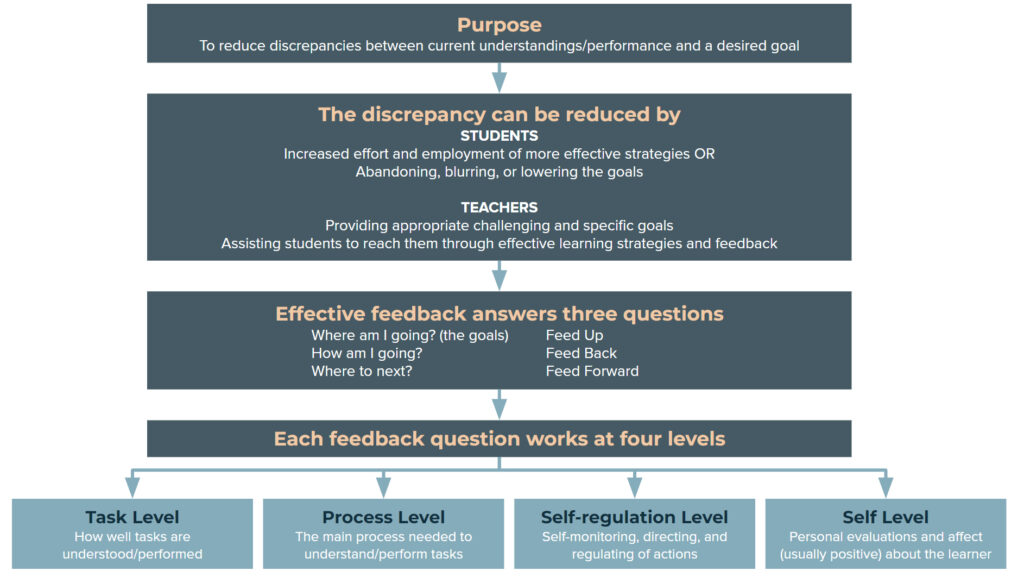Introduction
Feedback is “the delivery of information based on direct observation that is meant to improve performance.” (Jug et al., 2019). Based on this observation, an agent (eg. teacher or peer) provides information about one’s performance or understanding (Hattie & Timperley, 2007).
It is generally accepted that feedback leads to learning, improvement, and ultimately organizational success. That is why we see organizations spending so much on appraisals, so that progress can be made. Having said that, the scale of that improvement and progress is very much dependent on how we give, receive, and use the feedback. For example, overly harsh and unconstructive feedback ends up tearing down an employee and demotivating them instead of spurring them to improve.
In this post, I will explore the power of effective feedback by breaking down what effective feedback entails and studying a model for effective feedback. This corresponds with ISTE Standard 4.5b on building the capacity of educators, leaders, and instructional teams to put the ISTE Standards into practice by facilitating active learning and providing meaningful feedback.
A Model for Effective Feedback
The Purpose of Feedback
Hattie & Timperley (2007) presented a framework for feedback to enhance learning (see Figure 1). In this model, the authors suggest that as we reference current understanding and performance to a desired goal, feedback is the tool that helps to bridge that gap.

Source: Hattie & Timperley (2007)
Reducing Barriers to Goal Attainment
When considering an educational context, students’ desired understanding and performance can be increased if barriers towards goal attainment are reduced. For students, they can either put in more effort and work harder to achieve their goals or use more effective studying strategies, either through their own effort or be taught them. They could also have the goals lowered, thereby accepting a lower standard as satisfactory, or give up altogether, which reduces any gap between their performance and the desired goal.
Teachers can help students to reduce the gap between actual performance and desired goal attainment by clarifying goals, making them more specific, and ensuring that they are appropriately challenging. Teachers can also create a more conducive learning environment, helping students to learn more effectively by equipping them with learning strategies and error detection skills (Hattie, Biggs, & Purdie (1996) as cited in Hattie & Timperley (2007)). Throughout this entire process, feedback plays an important role in bridging the gap between actual performance and desired goals.
Effective Feedback
Besides imparting knowledge to students, effective teaching also involves components of evaluation and assessments to gauge students’ understanding. The latter is the feedback component and they should answer 3 questions to make the feedback effective:
- Where am I going? (referencing the set goals)
- How am I going?
- Where to next?
These 3 questions can be summarized as “feed up”, “feed back” and “feed forward”.
The Four Levels of Feedback Focus
Effective feedback should be focused and (Hattie & Timperley, 2007) presents four levels on which to focus feedback on, with effectiveness tied to the level at which the feedback is being directed.
- The Task Level
This level addresses feedback on how well a specific task is understood or performed. Teachers can guide students by directing them to acquire more, different, or correct information. An example of feedback at this level is, “You might want to consider using brighter colors if your goal is to create a happier mood.”
- Process Level
This level of feedback focuses on the process used to complete the task. Teachers can focus on how the student processes information and learns the information required to complete the task. An example of feedback at this level could be, “This model will make more sense if you include a summary for each of the items mentioned.”
- Self-Regulation Level
This level of feedback focuses on the student’s skills in self-evaluation and the confidence to move forward with the task. An example of such a feedback is, “You already know the list of power words that makes a headline more compelling. Check to see if you have incorporated that knowledge in your writing.” This type of feedback reinforces what the student already knows and helps them build the confidence to perform the task better. - Self level
This level of feedback is directed at the “self” as a person and is much more personal and may not be directly tied to a task. An example of this type of feedback is, “You are very hardworking. I see that you must have put in a lot of time and effort in your research.”
Effective Feedback in Practice
Hattie & Timperley’s model is a great starting point for which to frame feedback, starting with feedback being goal-referenced, down to the four levels at which to focus feedback on. Effective feedback, however, also involves timing and how the feedback is delivered.
The timing of feedback, whether the feedback is immediate or delayed may have an impact on the effectiveness of the feedback. At times, immediate feedback may work better but there is also merit in delayed feedback sometimes. While correcting a student’s error immediately may result in faster error correction and getting back on the right track for the student, such timing may also have unintended effects in other scenarios. Consider the example of a student practicing how to become a better public speaker. If the teacher stops the student in the middle of every sentence to correct mistakes, not only is this method of feedback disruptive, it may also dampen the student’s confidence.
Teachers should also distinguish between feedback and advice. They may appear to be similar but are in fact very different. Take a statement like this as an example:
“You should use brighter colors in your painting.”
This statement is advice and not feedback. When a statement is not preceded by descriptive feedback, it may come across annoying the receiver because the first natural response would be, “Why are you suggesting this?” (Wiggins, 2012)
A better way to go about this would be for the teacher to first ensure that they have permission to provide feedback, comprehended, and accepted the feedback before moving on to giving advice. So back to the example above, the teacher’s advice will be better received by the student if reframed in this manner:
“It looks like you’re making good progress with your painting. Would you mind if I give you some feedback to make your painting stand out? The dark colors you’ve chosen may make your painting blend too much into the background wall which is also of a dark color. You might want to consider using brighter colors so that your painting really stands out in the exhibit.”
References
- Hattie, J., & Timperley, H. (2007). The power of feedback. Review of Educational Research, 77(1), 81–112. https://doi.org/10.3102/003465430298487
- Jug, R., Jiang, X. S., & Bean, S. M. (2019). Giving and receiving effective feedback: A review article and how-to guide. Archives of Pathology & Laboratory Medicine, 143(2), 244–250. https://doi.org/10.5858/arpa.2018-0058-ra
- Wiggins, G. (2012, September 1). Seven Keys to effective feedback. ASCD. Retrieved February 19, 2022, from https://www.ascd.org/el/articles/seven-keys-to-effective-feedback


Practical and insightful reflection on how to approach feedback well. Thanks for your post! I particularly appreciated the three question framework which, for me, really helps refine the purpose of feedback. The questions seem to be a slightly more helpful way of identifying the “so what”….i.e. our objective(s)…in whatever we do. Seems like these are questions we can always ask of ourselves when engaging authentically in work-related tasks, certainly within the world of education but also outside of it. Food for thought!
I really enjoyed your post and I thought the purpose of feedback, particularly the diagram, was interesting! I noticed that you said timing can have a big impact on the effectiveness of the feedback so it got me wondering if the medium or amount of feedback had a significant impact too, the majority of the feedback I have received over the years tends to be written – I think it’s because this provides a trail and something to point back to, but I wonder if video/audio feedback is better or the same for students? I feel like it could make a difference because you can hear tone and style of delivery, but I wonder if there’s a way to have written feedback still convey the same tone or not…especially for those of us (me) who tend to be concise and possible terse at times in their writing. :-/